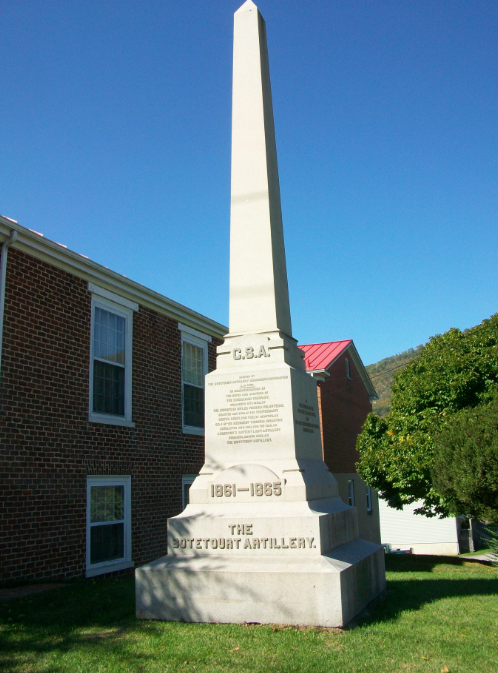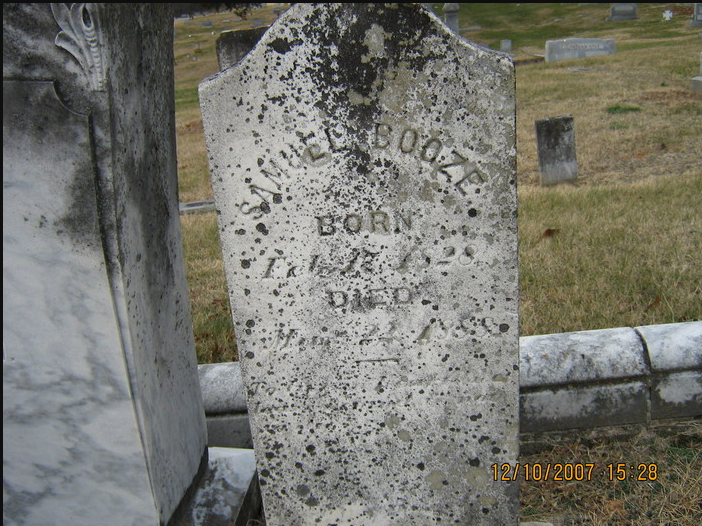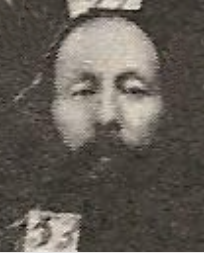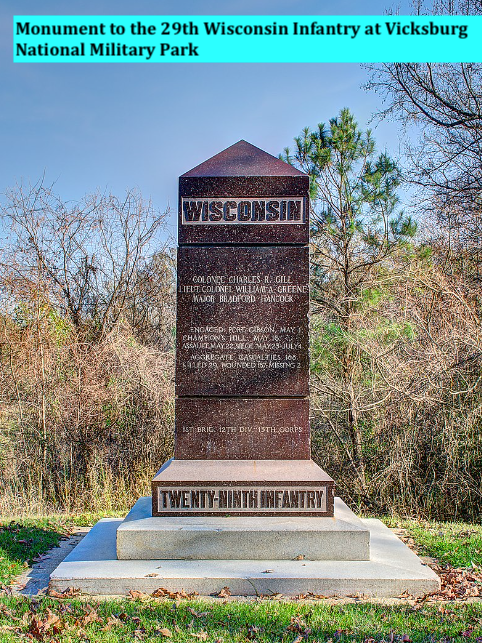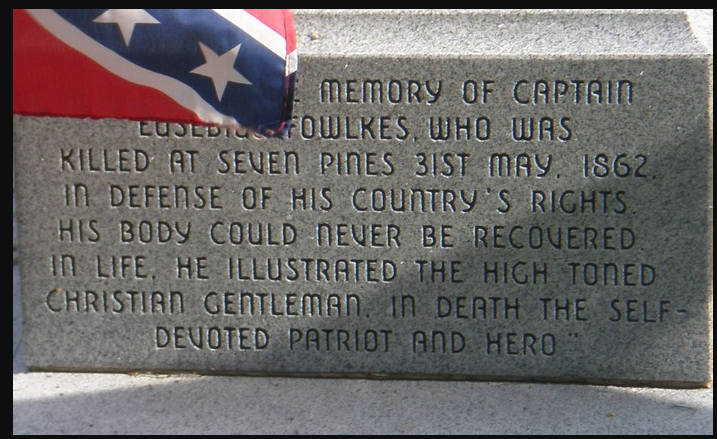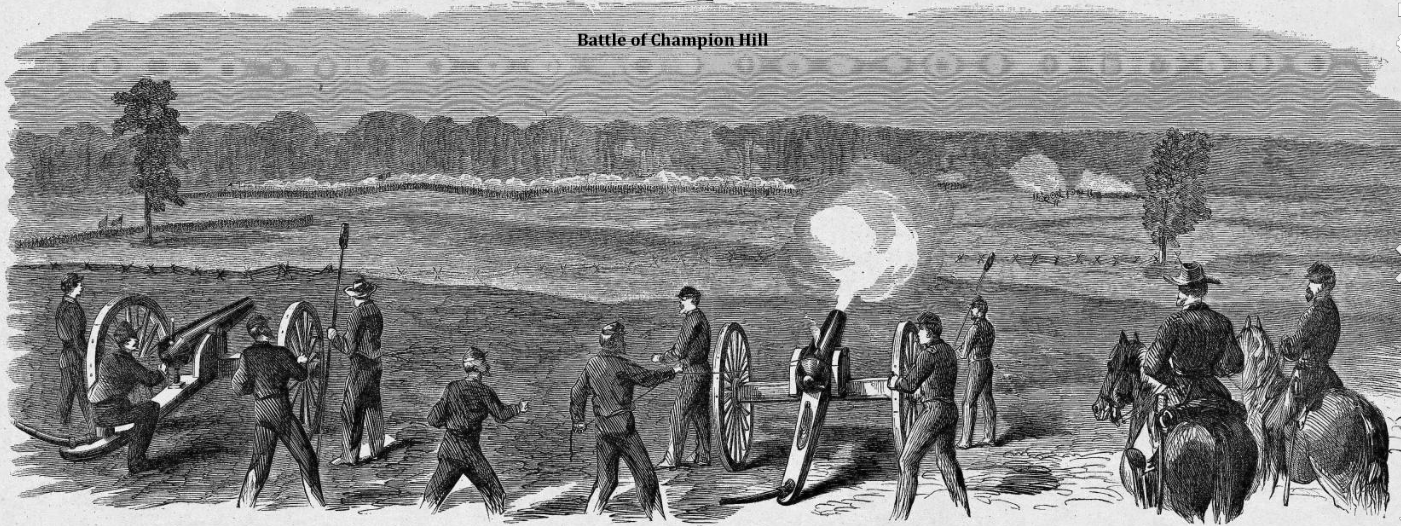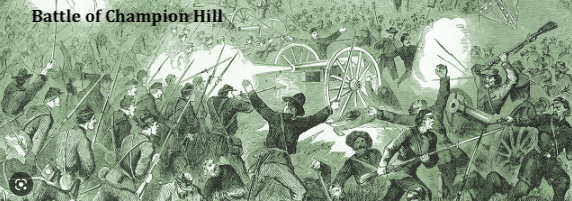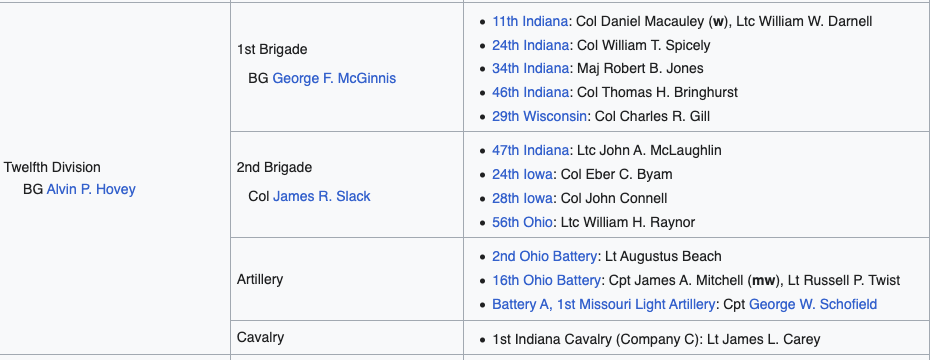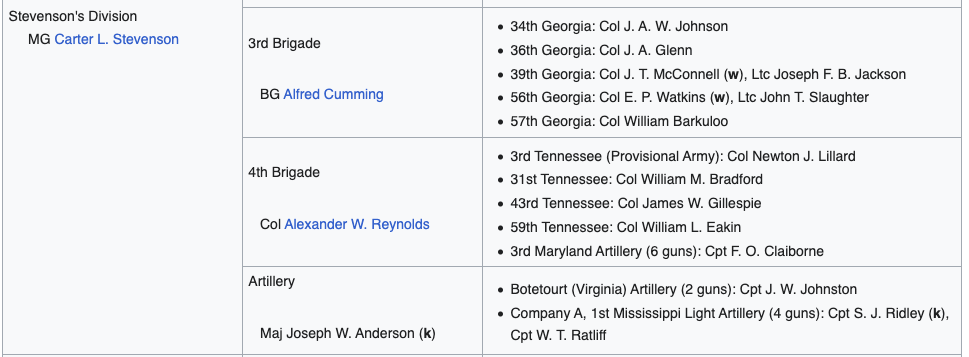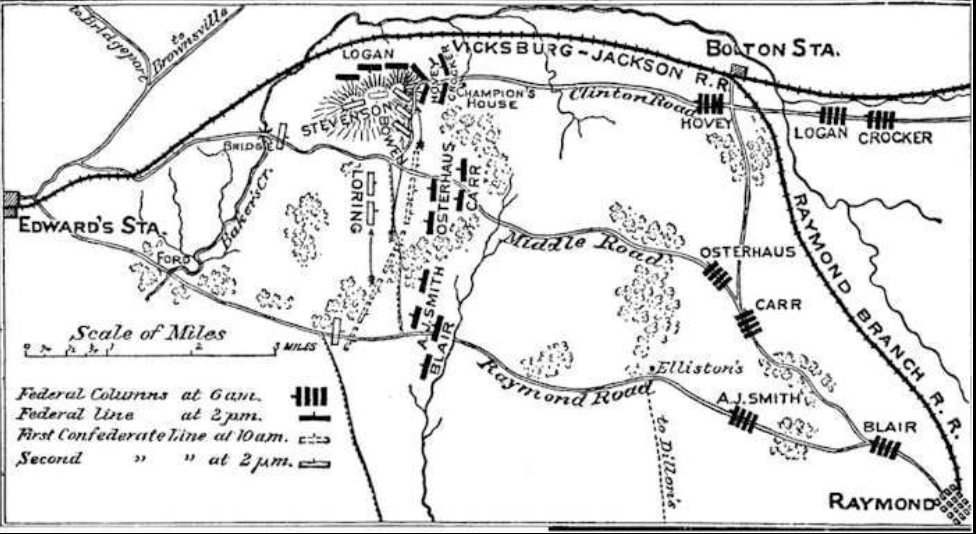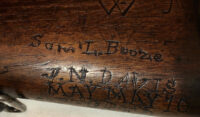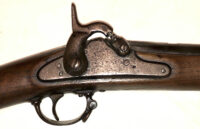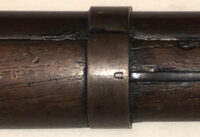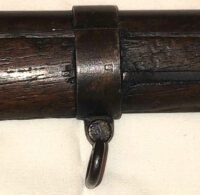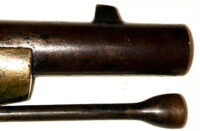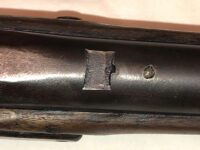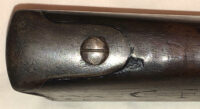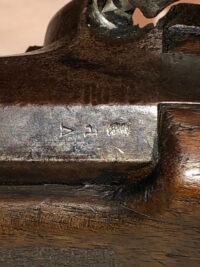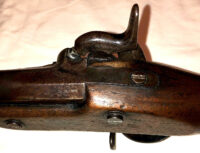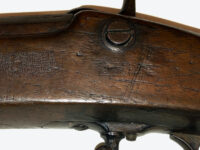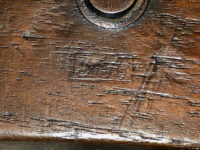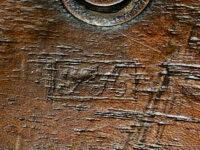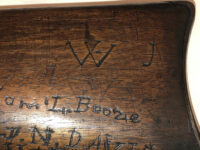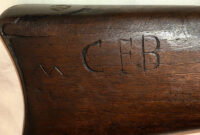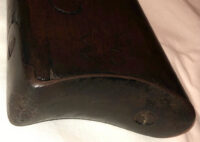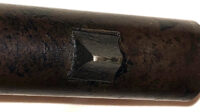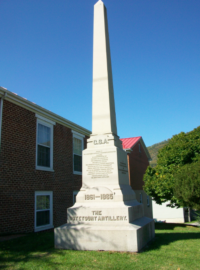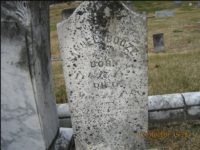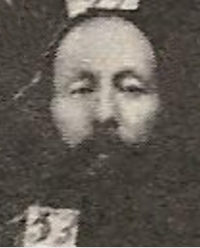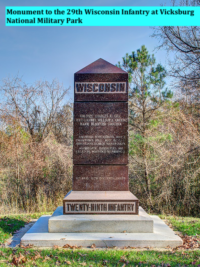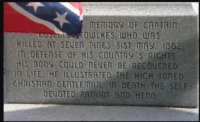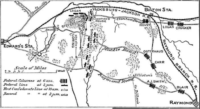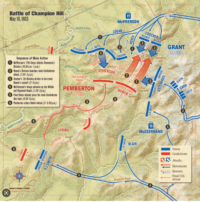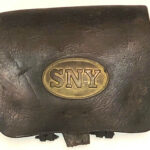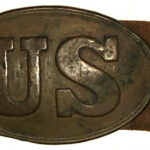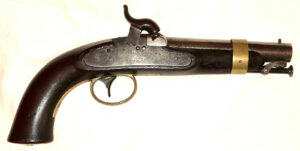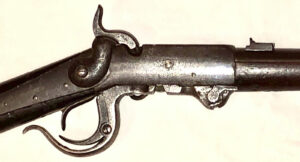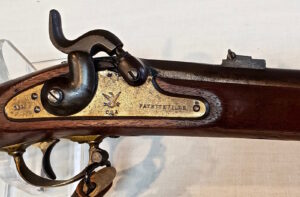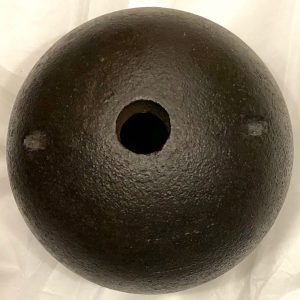Rare Id’d Confederate CS Richmond Carbine – Samuel Booze and Charles F. Blount, Botetourt Light Artillery Captured at the Battle of Champion Hill, Mississippi; Sgt. John N. Davis 29th Wisconsin Infantry – Overran the Botetourt Light Artillery on May 16, 1863 at Champion Hill, Mississippi
SOLD
Rare Id’d Confederate CS Richmond Carbine – Samuel Booze and Charles F. Blount, Botetourt Light Artillery Captured at the Battle of Champion Hill, Mississippi; Sgt. John N. Davis 29th Wisconsin Infantry – Overran the Botetourt Light Artillery on May 16, 1863 at Champion Hill, Mississippi – This rare, early production example of a CS Richmond carbine remains in overall, very good condition. The low or medium hump lock plate is unmarked, indicative of an early production weapon, perhaps initially destined for Fayetteville. The carbine has a brass nose cap and iron butt plate; the latter appears to have been constructed at the Richmond Armory, as the stock was seemingly fashioned by shortening a rifle stock, in the period, and then fashioning an appropriate, iron butt plate; this shortening process has been observed in several extant, early, Richmond carbine specimens. The flat barrel bands, from US M1855 rifles, exhibit the “U” on their right side; as with all Richmond rifles, the “U” lines up reasonably well with the lower, band spring, but is distinctly off center, with the upper band spring. Clearly stamped on the left, back side of the breech, just forward of the breech plug, are the following stampings: “V P” and an eagle’s head; the “P”, like most Richmond assembled weapons, exhibits a “broken” loop section of the letter “P”. On the flat, opposite the lock plate, is the rarely encountered inspection stamp – “SA” indicating that this weapon had been inspected by the Richmond Armory’s chief armorer, Salmon Adams. The presence of Adams’ cartouche is indicative that this carbine is an early production example – Richmond carbines were assembled starting in November of 1862. The gun retains its original, tulip-type ramrod; the bore is worn, but clean. The rear sight is missing, although the original, single bladed, “pinched nose”, front sight remains. Removal of the lock plate revealed that the lock mortise of this carbine exhibits the Richmond stock “mule shoe”. We have had this carbine examined by several noted and highly respected Confederate weapons authorities – all unanimously concur that this gun is exactly as we have described it here, and that it is completely authentic and original in all regards.
Measurements: OL – 39.25”; Barrel Length – 25”; Stock Length – 36”
The butt stock of this fine example of a CS Richmond carbine, confirms its wartime provenance – there are deeply carved names and initials, as well an important date and battle location, thereby making this carbine one of the more historic Confederate firearms we have encountered. Clearly carved on the underside of the butt stock, just past the end of the trigger guard, is the following:
“SamL Booze
J.N. Davis
MAY MAY 16
CAPTURED
VA BATTERY”
The style of carving of the Booze name, is distinctly different than that of Sergeant Davis, indicative of the fact that Booze must have carved his name in the stock upon being issued the weapon, and Davis carving his name upon the date of his capturing the weapon.
Also, carved in the underside of the “toe” area of the butt stock, just beyond the end of the trigger guard, are two sets of initials:
“CFB”
“WJ”
Research of the Botetourt Light Artillery indicates the following identities:
Samuel Booze, a 33 year-old private, who enlisted, as a substitute, in the Botetourt Light Artillery, in February, 1862; although the Botetourt Light Artillery, initially formed as part of the 28th Va. Infantry, it shortly thereafter became officially designated as the Botetourt Light Artillery; this regiment would be one of the very few Virginia units sent to the Western Theater. On May 16, 1863, the regiment, during the Battle of Champion’s Hill, Mississippi, part of Grant’s Vicksburg Campaign, would be overrun by the 29th Wisconsin Infantry; most of the soldiers in the Botetourt Light Artillery were subsequently captured; indeed, Booze was one of this group of POWs.
Also deeply carved in the butt stock are the initials CFB – these are the initials of Charles F. Blount, also a private in the Botetourt Light Artillery; Private Blount was also captured during the same period as Private Booze, in Mississippi. Both Booze and Blount would later be exchanged.
As of this posting, we have not been able to definitively establish the identity of the soldier who carved his initials – “WJ”.
Also, significantly, deeply carved in the stock, in the same area, just beneath Private Booze’s name, is the name J.N. Davis – Sergeant John N. Davis was a member of the 29th Wisconsin Infantry; this regiment was the unit that overwhelmed the Botetourt Light Artillery, on May 16, 1863, at the Battle of Champion’s Hill, Mississippi. Davis would survive the war, mustering out in 1865.
Combined with the rarity of a fine condition, CS Richmond carbine, inspected by Salmon Adams, is the extreme rarity of finding a battle-captured, Confederate firearm, with the identities of two of the Confederate combatants carved in the weapon’s stock, as well as the identity of the Union solder who captured the two Confederates, augmented by the date on which the capture occurred. This is a rare and historically important Confederate firearm.
This excellent example of a CS Richmond carbine is definitively represented by the following Richmond carbine synopsis, expertly composed by Tim Prince of the College Hill Arsenal:
“During the course of the American Civil War, no Confederate arms manufactory ever produced as many firearms for the Confederate cause as the Richmond Armory. The armory utilized the rifle musket making machinery captured at the US arsenal in Harper’s Ferry, and managed to produce more than 37,000 long arms, not counting the thousands of weapons that were repaired and altered at that facility. The largest majority of that production were rifle muskets, based upon the US M1855/61 patterns, with just over 31,000 produced between October of 1861 and January of 1865; no new arms are known to have been produced at Richmond after January of 1865. The second largest group of long arms was the .58 caliber Rifled Carbine, with about 5,400 produced between November of 1862 and January of 1865. One thing that makes Richmond Carbines so unique that they are the most inconsistent of Richmond made arms in terms of features. Many Richmond carbines were assembled with a mixture of Richmond made parts and older parts that were on hand from Harpers Ferry or from parts scavenged from damaged arms and battlefield recoveries. In fact, thanks to Paul Davis’ research in his authoritative book CS Armory Richmond, we know that at least 622 .58 caliber Richmond carbines were produced utilizing “old barrels”. Other parts from salvaged US arms that are known to be used on Richmond carbines include M1861 locks, M1855 stocks and patch boxes, M1861 nose caps and M1861 iron butt plates, just to name a few.
Richmond Rifled Carbines do have a number of consistent features. They are nominally 41” in overall length, with a barrel that is 25” long, secured to the nominally 38 ““ stock by two spring-retained, flat, solid iron barrel bands. The bands are usually stamped with the “U” mark indicating UP, but are usually much less consistently marked than their US made counterparts. The majority of Richmond carbines have a plain, unmarked brass butt plates, but do appear with repurposed iron buttplates as well. Later production, Richmond-made brass nose caps secured by a single iron screw are most common, but again earlier production Richmond nose caps, as well repurposed US nose caps appear as well. Most surviving examples have Richmond produced locks, although re-used US locks are not unknown. The standard rear sight was a Richmond produced sight based upon the US M1858 rear sight, while other salvaged US sites do appear from time to time. The front sight was a very distinctive, Richmond-made “pinched” front sight that was brazed to the barrel about 1” from the muzzle. The ramrod was typically a Richmond-made, thin-shank iron rod with a tulip shaped head and without the swell found on US M1855 and M1861 style rods. The guns were equipped with three sling swivels instead of the more conventional carbine sling bar and ring. Two swivels were mounted in the traditional long arm locations; on the trigger guard and the upper barrel band. The third was screwed into the toe of the stock about 1“ from the rear of the trigger guard tang. Most of the guns utilized Richmond made stocks, with the lock mortise inlet with the distinctive “Mules Foot” bearing surface in the wood, and without the additional cut outs needed to accommodate the M1855 Maynard Tape Priming lock works. However, at least some older M1855 stocks were utilized, and a number of the carbines were produced with M1855 style iron patch boxes. The Richmond made stocks are typically unmarked.”
From “THE RICHMOND ARMORY” by Benjamin P. Michel:
“The production report of January 1,1864, indicates that for the preceding two years a total of 23,381 rifle muskets were produced at Richmond of the Model 1855, along with 1,225 muskets Model 1842 (probably assembled from captured parts) and 2,764 rifle carbines. (Note the use of the term rifle carbines.) On December 21,1864, General Gorgas Figure 1. Richmond Rifle Musket. reported to the Confederate Secretary of War, James A. Sedden, that as of the year ending November 30,1864, some 12,778 more rifles and 5,354 carbines had been manufactured and made up of parts derived from capture. Because of this habit of mixing the returns of manufactured and assembled arms, it is difficult to accurately determine the total arms actually produced at Richmond. It may be roughly assumed that the total rifle musket production was between 30,000 to 35,000 and carbine production somewhat less than 10,000, perhaps as little as half that, assuming the 1864 returns for carbines must include a significant number of federal weapons and the Richmond Sharps as well. Gorgas estimated in this last report that the Armory was capable of producing 25,000 arms per year, using some 450 workmen. The expectation never, of course, could be realized, the city of Richmond being evacuated in 1865, and the buildings comprising the Armory being gutted by fire on the morning of April 3 of that year. That the Confederacy hoped to renew production at some other location is evidenced by the fact that when the buildings burned, the contents had apparently already been removed. The final postscript appears in Major General Wright’s reports from Danville, Virginia, of April 27,1865, advising of the capture of 500 prisoners, 4 locomotives, 67 box and platform cars, the iron work for 10,000 stand of arms, and last ‘the machinery for manufacturing muskets, etc., taken from Harpers Ferry and subsequently from Richmond.”
Salmon Adams:
In the closing months of 1861 the Richmond Armory ran numerous classified advertisements for skilled workers in the Richmond Dispatch in hopes of adding as many skilled laborers to their workforce as possible to outfit CS Armies in the field. An ad dated October 12 stated, “WANTED- At the Confederate States Armory, in this city, two PATTERN MAKERS and four good SMITHS, Apply to Mr. SALMON ADAMS, Master Armorer, at the Armory, Satisfactory reference required. JAS. H. BURTON, Sup’t.33
The Armory was in need of workers to facilitate faster production and with the large numbers of able-bodied men in the ranks of the 32Ibid. Burton-Gorgas letter, November 18, 1862, 85. 33 Richmond Dispatch, October 12, 1861. 18 Confederate Army, workers (especially skilled ones) were hard to come by. Workers that possessed specialized skills were a precious commodity during the War, and the Armory worked to secure draft exemptions for these workers.
Additionally, the classified advertisements placed by the Armory would have been considered competition by other foundries in the city, particularly at the nearby Tredegar Iron Works. By early 1862, the state legislature passed a conscription act that established enrollment in the militia for all males between 18 and 45 years of age, but Gov. Letcher worried about Richmond because of the city’s manufacturing capabilities, which, he noted, “are doing so much to uphold the Southern Confederacy and its loss to us would be well night irreparable.”34 Upon the governor’s urging, and “to protect the economy of the home front, the legislature subsequently adopted exemptions, emphasizing public officials, local civil servants, ministers, doctors, and officers of businesses essential for communications in the state- telegraph, canal, and railroad companies.”35 The majority of Richmond Armory workers received exemptions as their work was seen as essential to the Confederate war effort as Confederate legislation of April 16, 1862 exempts, “All shoemakers, tanners, blacksmiths, wagon makers, millers and their engineers and mill-wrights, skilled and actually employed on the 16th of April, 1862, in said trades as their regular vocation, and working therein for the public, and who have since said time been so regularly employed.” C.S. Richmond’s Master Armorer, to whom the aforementioned job applications went, was Mr. Salmon Adams. Adams was born in Springfield, Massachusetts, in 1819 and at one time had been employed as an arms inspector at Springfield Armory. Virginia’s Private War: Feeding Body and Soul in the Confederacy, 1861-1865 (Oxford: Oxford University Press, 1998), 49. 35 Ibid. p. 49 36 “Confederate States of America, Congress. House of Representatives. A Bill: To exempt certain persons from military duty, and to repeal the acts heretofore passed by Congress on the same subject.” University of North Carolina. Accessed July 2014.
Adams’s pre-war correspondence hints at his awareness of an oncoming conflict, and he was attempting to amass arms for Virginia before it was too late. Writing to Secretary of War John Floyd from Springfield Armory in November 1860:
My DEAR SIR: Please allow me to address a line to you on a matter that deeply interests your State. Having been engaged in the Springfield Armory for fifteen years last past, and knowing that assistance has been rendered and privileges granted to foreign Governments and to some of our own states, as well as to private individuals, I desire the same favors granted to the State of Virginia. I have no hopes of any favors from Colonel [Henry K.] Craig, for in a conversation with him a few months since I found him deadly opposed to the Virginia Armory. “We wish to use some of the armory patterns for the Richmond machinery, and the privilege of taking drawings of fixtures, tools, &c. “I desire that the honorable Secretary issue an order to the superintendents of the Springfield and Harpers Ferry armories to give the master armorer of the Virginia State Armory and Joseph R. Anderson or his agents every facility they may need in said armories, at the same time not interfering with the legitimate business of the armory. “I desire to get all the assistance we can from the national armories before our much-honored and esteemed Secretary of War vacates his office, for I have no hopes of any assistance after a Black Republican takes possession of the War Department. Should the honorable Secretary see fit to grant the request of the petitioner, I wish a copy of the order to be sent to me at Springfield, Mass, as I shall be engaged here for a couple of months getting up a model gun for the State of Virginia. Your humble servant, S. Adams, Master Armorer State Armory Virginia.”
Hired as Master Armorer in Richmond, Adams seemed to be a strong Southern sympathizer as his letter suggests. It is unclear how Salmon Adams transitioned from arms inspector at Springfield Armory to Master Armorer for the state of Virginia, and then to inspector at the Richmond Armory but his sympathies stayed with the Confederacy as he was employed at the Armory from 1861 until the end of the war. Salmon Adams had known Burton. From Under Iron Eyelids: the Biography of James Burton, Armorer to Three Nations. Adams-Floyd letter, November 24, 1860, prior to the outbreak of the war as Burton had dealings with the Springfield Armory when he was Master armorer at Harpers Ferry. As inspector, Adams, one of the senior officials at the armory, would have reported to Burton. It was the job of Mr. Adams to inspect and stamp his initials into finished Richmond rifles as they left the armory, bound for the front.
Additional Research – from a description of a CS Richmond rifle offered for sale: Manufactured from 1861-65, these arms were made with machinery captured from the Harpers Ferry Armory in April of 1861 and moved to Confederate ordnance facilities in Richmond, Virginia. This carbine has the distinctive “humpback” lock which was made from forgings and dies taken from Harpers Ferry Armory. The locks were originally intended for use with the Maynard tape priming system on the U.S. Model 1855 rifled musket. Richmond Armory had no use for the priming device, so to quicken production they merely used the old dies.
Manufactured with machinery captured from the U.S. Arsenal at Harper’s Ferry, Virginia, in 1861, the Richmond Armory Rifle Muskets conformed to the same general configuration as the U.S. Model 1855 Rifle Muskets. The left side of the barrel has “V/P/Eagle Head” proofs/inspection marks (faint). The left stock flat is stamped with a recut “SA” (Salmon Adams, Master Armorer at Richmond Armory) cartouche.
Samuel Booze
| Residence was not listed; 33 years old.
Enlisted on 2/8/1862 at Richmond, VA as a Private.
On 2/8/1862 he mustered as a substitute into VA Botetourt Light Artillery (date and method of discharge not given) (Substitute for Andrew P. circle) He was listed as: * Detailed 4/20/1862 (place not stated) (As Quartermaster Sergt) * Issued clothing 3/15/1863 (place not stated) (Estimated day) * POW 5/16/1863 Champion Hills, MS (Exchanged) * Returned 7/14/1863 (place not stated) * Sick furlough 8/31/1863 (place not stated) * Returned 12/25/1863 (place not stated) * Hospitalized 1/2/1864 White Sulphur Springs, WV * Issued clothing 2/9/1864 (place not stated) * Furloughed 2/14/1864 White Sulphur Springs, WV (To his home from hospital) Other Information: born 2/18/1829 died 10/26/1922 Buried: Fairview Cemetery, Botetourt County, VA
Samuel Booze
Botetourt VA Light Artillery Battery
|
|||||||||||||||||||||||||||||||||||||||||||||||||||||||||||||||||||||||||||||||||||||||||||||||||||||||||||||||||||||||||||||||||||||||||||||||||||||||||||||||||||||||||||||||||||||||||||||||||||||||||||||||||||||||||||
|
|
|||||||||||||||||||||||||||||||||||||||||||||||||||||||||||||||||||||||||||||||||||||||||||||||||||||||||||||||||||||||||||||||||||||||||||||||||||||||||||||||||||||||||||||||||||||||||||||||||||||||||||||||||||||||||||
Botetourt Artillery
SUMMARY
The Botetourt Artillery was one of only a handful of Virginia units to serve in the Western Theater during the American Civil War (1861–1865). Organized in December 1861 from a company in the 28th Virginia Infantry Regiment, the unit experienced heavy combat and losses during the Vicksburg Campaign in the spring and summer of 1863. Following Vicksburg, the Botetourt Artillery returned to western Virginia, where it saw little action.
Contributor: Frank B. Atkinson
At the beginning of the Civil War, the local militia company from Botetourt County, dubbed the “Mountain Rifles,” mustered for service. As part of the 28th Virginia Infantry, the men took part in the First Battle of Manassas (1861). Under the terms of the Confederate Conscription Act, during the winter of 1861–1862, many of the soldiers opted to reenlist and transfer to the artillery, a branch often perceived as less demanding than the infantry. In a typical Confederate practice, the battery became known as Anderson’s Battery after the name of its captain, Joseph W. Anderson.
In April 1862, the battery was transferred to eastern Tennessee and subsequently issued six iron guns. The unit participated in the Battle of Tazewell and the investment of Cumberland Gap in August and September. Anderson’s Battery entered Kentucky as part of Confederate general Kirby Smith’s army in October, but saw no action. In December, the unit transferred to Mississippi and fought in the Battle of Chickasaw Bayou. In January 1863, Captain Anderson received a promotion and John W. Johnston assumed command. Henceforth, the battery was known as the Botetourt Artillery.
During Union general Ulysses S. Grant‘s final offensive to capture the strategically crucial Mississippi River town of Vicksburg, the battery took a conspicuous part in the Battle of Port Gibson. On May 1, 1863, Confederate forces blocked the Bruinsburg and Rodney roads that led inland from the Union landing on the Mississippi River. The artillery initially deployed twelve-pound Napoleons and Howitzers—two of each—on Bruinsburg Road, but the Howitzers later moved to Rodney Road. There, Union troops overran the Confederate position, capturing the guns. The cannoneers on Bruinsburg Road fared better and held Union forces at bay for several hours. Later, two additional six-pound cannon arrived, but on entering the field, the horses, guns, and carriages became entangled, preventing their deployment. The entire battery managed to escape with only a six-pound cannon and a Napoleon. Out of 116 men in the engagement, 37 were killed, wounded, or captured, along with 53 horses.
Confederate forces again blocked the Union advance at the Battle of Champion Hill on May 16, 1863. The remaining two guns of the battery were deployed in a defensive position on the crest of Champion Hill. A fierce Union attack eventually overran this position and these cannon were captured also. The Confederate army retreated to Vicksburg.
During the siege of Vicksburg (May 18–July 4, 1863), the Botetourt Artillery manned two six-pound guns on the siege line while the remaining battery members served as infantry. On July 4, 1863, the battery surrendered with the rest of the Confederate army defending Vicksburg.
Following Vicksburg, the battery was exchanged and returned to western Virginia for the duration of the war. The men did not see any more major action, although they assisted in defending Lynchburg from Union general David Hunter in 1864. The Botetourt Artillery disbanded on April 12, 1865, at Christiansburg, Virginia.
Charles F. Blount
| Residence was not listed; a 22 year-old Carpenter.
Enlisted on 5/15/1861 at Buchanan, VA as a Private.
On 5/15/1861 he mustered into “H” Co. VA 28th Infantry He was transferred out on 12/24/1861
On 12/24/1861 he transferred into VA Botetourt Light Artillery (date and method of discharge not given) He was listed as: * On rolls 12/15/1861 (place not stated) * Detailed 5/1/1862 (place not stated) (As Forage Master & Picket Sergt) * Returned 8/30/1862 (place not stated) * POW 7/4/1863 Vicksburg, MS * Paroled 7/8/1863 Vicksburg, MS * Exchanged 7/21/1863 Enterprise, MS (Sick furlough) * Issued clothing 8/15/1863 (place not stated) * Returned 1/10/1864 (place not stated) (To Company) * Detailed 4/3/1864 (place not stated) (As Picket Sergt) * Detailed 4/13/1864 (place not stated) (Sawing Government timber) * On rolls 10/31/1864 (place not stated) (Present) Other Information: born in 1839 (Last name: Blount or Blunt. Living in Elliston, VA Aug 1909. Died of cancer. Widow: Emmpa P. Blount recd pension Oct 1920.)
John N. Davis
29th Regiment, Wisconsin Infantry OVERVIEW: Organized at Madison, Wis., and mustered in September 27, 1862. Moved to Cairo, Ill., thence to Helena, Ark., November 2-7, 1862. Attached to 3rd Brigade, 12th Division, District of Eastern Arkansas, Dept. of the Tennessee, to January, 1863. 3rd Brigade, 12th Division, 13th Army Corps, Dept. of the Tennessee, to February, 1863. 1st Brigade, 12th Division, 13th Army Corps, to July, 1863. 1st Brigade, 3rd Division, 13th Army Corps, Army of the Tennessee, to August, 1863, and Dept. of the Gulf, to June, 1864. District of LaFourche, Dept. of the Gulf, to August, 1864. 2nd Brigade, 2nd Division, 19th Army Corps, Dept. of the Gulf, to December, 1864. 1st Brigade, Reserve Corps, Military Division West Mississippi, to February, 1865. 1st Brigade, 1st Division, Reserve Corps, Military Division West Mississippi, February, 1865. 1st Brigade, 1st Division, 13th Army Corps (New), Military Division West Mississippi, to June, 1865. SERVICE: Expedition from Helena, Ark., to Arkansas Post, November 16-21, 1862. Duty opposite Helena till December 23. Action at Helena December 5. Moved to Helena December 23, thence to Friar’s Point, and duty there till January 7, 1863. Expedition up White River to Devall’s Bluff January 11-23. At Helena till April 10. Ordered to Milliken’s Bend, La., April 10. Movement on Bruinsburg and turning Grand Gulf April 25-30. Battle of Port Gibson , May 1 (Reserve). Battle of Champion Hill, May 16. Siege of Vicksburg , Miss., May 18-July 4. Assaults on Vicksburg May 19 and 22. Advance on Jackson, Miss., July 4-10. Siege of Jackson July 10-17. Ordered to New Orleans, La., August 6, thence to Brashear City September 15, and duty there till October 2. Western Louisiana Campaign October 3-November 30. Carrion Crow Bayou November 3. At New Iberia till December 19. March to Berwick December 19-21, thence to Algiers December 22-25. Moved to Pass Cavallo, Texas, January 5-12, 1864. Duty at DeCrow’s Point till February 20. Moved to New Orleans February 20-23, and duty at Algiers till March 5. Red River Campaign March 10-May 22. Advance from Franklin to Alexandria March 14-26. Battle of Sabine Cross Roads , April 8. Monett’s Ferry, Cane River Crossing, April 23. At Alexandria April 26-May 13. Construction of dam at Alexandria April 30-May 10. Graham’s Plantation May 5. Retreat to Morganza May 13-20. Duty at Morganza till June 13. Expedition to the Atchafalaya May 30-June 6. Moved to Carrollton June 13, thence to Kennersville June 21, and to Thibodeaux June 26, and duty there till July 9. Moved to Algiers July 9, and to Morganza July 26. Morgan’s Ferry Road and Atchafalaya River July 28. Moved to Port Hudson August 23. Expedition to Clinton August 23-29. Moved to Morganza August 29, thence to St. Charles, Ark., September 3-11, and duty there till October 23. Expedition to Devall’s Bluff October 23-November 12. Moved to Little Rock, Ark., November 12, thence to Memphis, Tenn., November 25, and duty there till January, 1865. Expedition to Moscow to assist Gen. Grierson December 21-31. Ordered to New Orleans, La., January 1, 1865, thence to Kennersville Station, and duty there till February 5. Moved to Dauphin Island near Mobile, Ala., February 5. Campaign against Mobile and its defences March 17-April 12. Siege of Spanish Fort and Fort Blakely March 26-April 8. Assault and capture of Fort Blakely , April 9. Occupation of Mobile April 12 to May 26. Moved to New Orleans, La. thence to Shreveport May 26-June 8, and duty there till June 22. Mustered out June 22, 1865. Regiment lost during service 1 Officer and 76 Enlisted men killed and mortally wounded and 3 Officers and 242 Enlisted men by disease. Total 322. 29th WI Infantry
Twenty-ninth Infantry
29th Wisconsin Infantry HistoryThe 29th Wisconsin Infantry was organized at Camp Randall in Madison and mustered into service on September 27, 1862. It left Wisconsin for Cairo, Illinois, and then traveled to Helena, Arkansas, during November 2-7, 1862. It moved through Arkansas, Mississippi, Louisiana, Texas, Tennessee, and Alabama during the war. The 29th Wisconsin Infantry participated in the battles of Port Gibson, Champions Hill, Sabine Cross Roads, the sieges of Vicksburg and Jackson, the Red River Campaign, the campaign against Mobile and its defenses, the siege of Spanish Fort and Fort Blakely, and the assault and capture of Fort Blakely, Alabama. The regiment mustered out of active service, June 22, 1865, in Shreveport, Louisiana, after having lost 322 men during service. One officer and 76 enlisted men were killed or mortally wounded. Three officers and 242 enlisted men died f |
||||||||||||||||||||||||||||||||||||||||||||||||||||||||||||||||||||||||||||||||||||||||||||||||||||||||||||||||||||||||

























